Italian Panettone (Giorilli panettone)
This post may contain affiliate links. For more information, please see our disclosure policy.
Giorilli is considered to be one of the best panettone bakers in the world!! To quote the original recipe website, “This panettone is light as a feather, an enchanting, aromatic, fragrant and infinitely good unfriendliness.“ Who can resist?!?
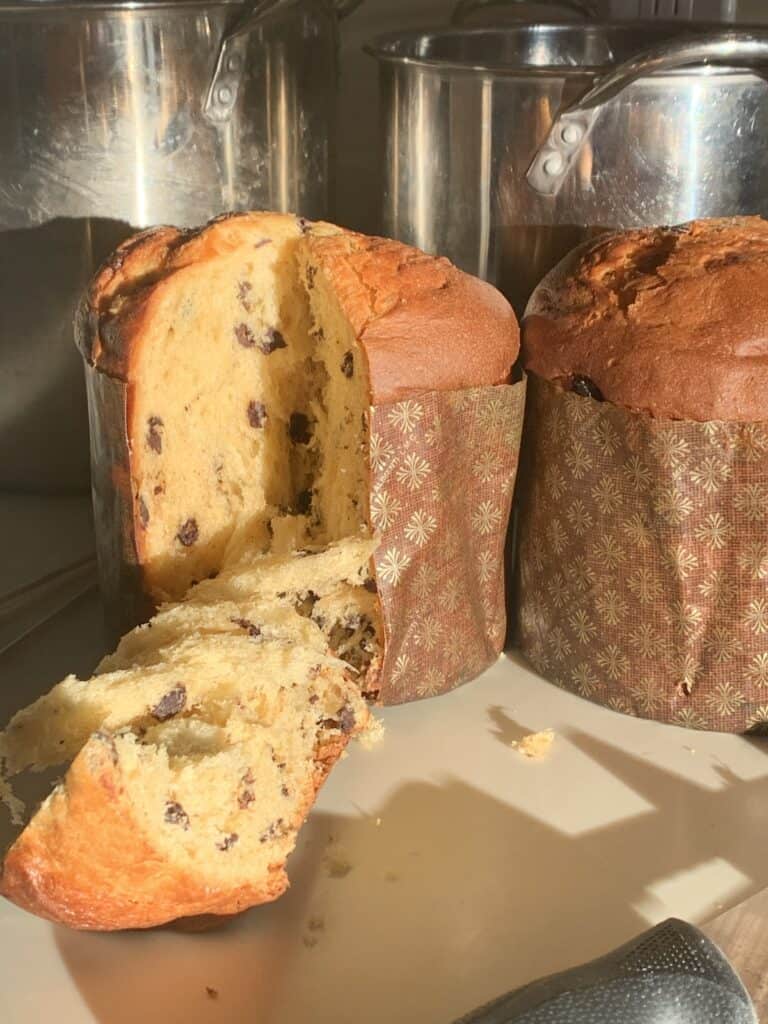
Overview of Panettone Making Process
This is definitely an **advanced** recipe, for those who want a challenge. It is well worth the effort!
You will need an established sourdough starter/levain (can be either liquid or solid, which is called pasta madre). Pasta madre is said to be the better choice, but I have successfully used both (I will always opt for pasta madre now and that will be the subject of another post).
You will also need a standing mixer, panettone cases, and skewers or needles to insert at the bottom of the panettone so you can flip it over after baking to prevent collapsing. It is also highly recommended to have a thermometer to monitor the dough temperature and also a thermometer to gauge/monitor the temperature of the area where you will rise the dough.
The dough is made over 2 days, assuming you have an active pasta madre or liquid starter/levain.
On day 1, you will make the “first dough” and then let it sit for 12 hours (or overnight) and then you will add ingredients to make the “second (ie, final) dough”, which is then ultimately baked.
In addition to your starter being active and healthy, time and temperature control are critical to the success of panettone making.
It has often been said that making a good panettone is 90% about the health and vitality of your starter (levain) and 10% about the proper dough strength and temperature control during fermentation.
The Ingredients: First dough (panettone)
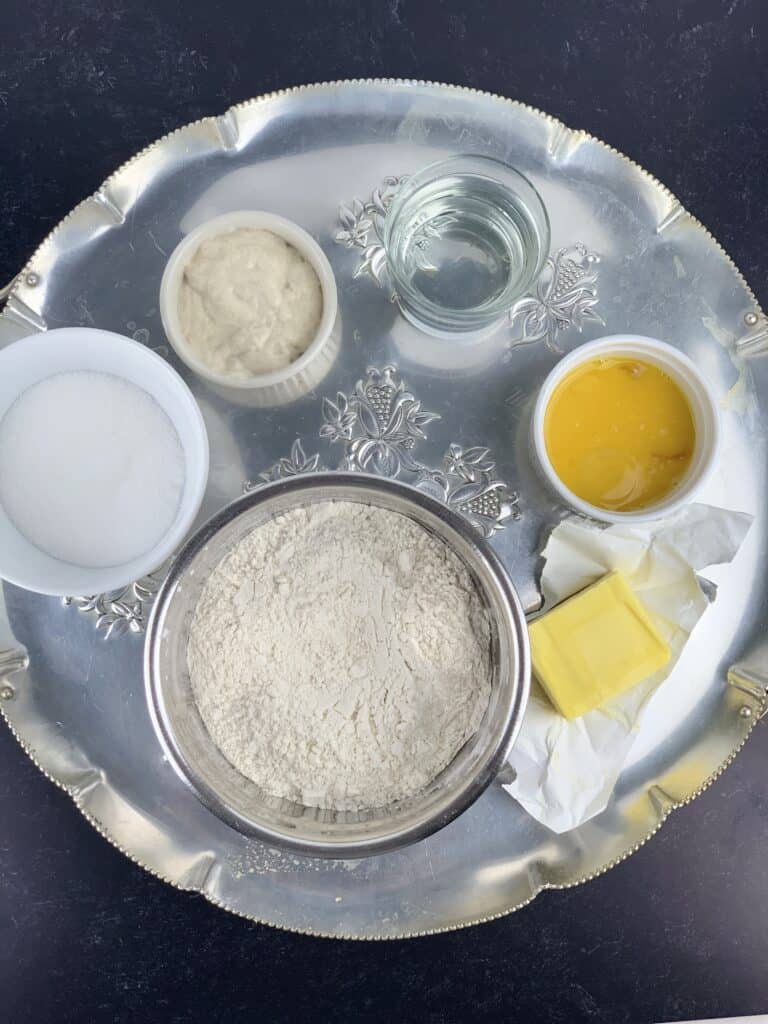
Ingredients for second dough (panettone):
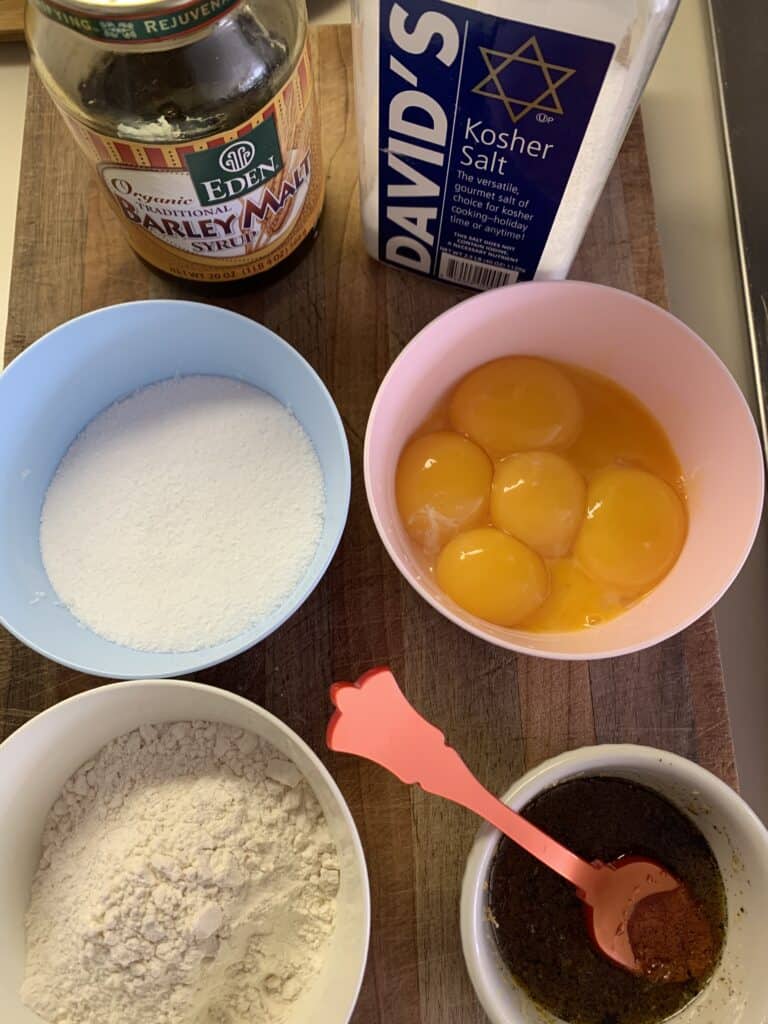
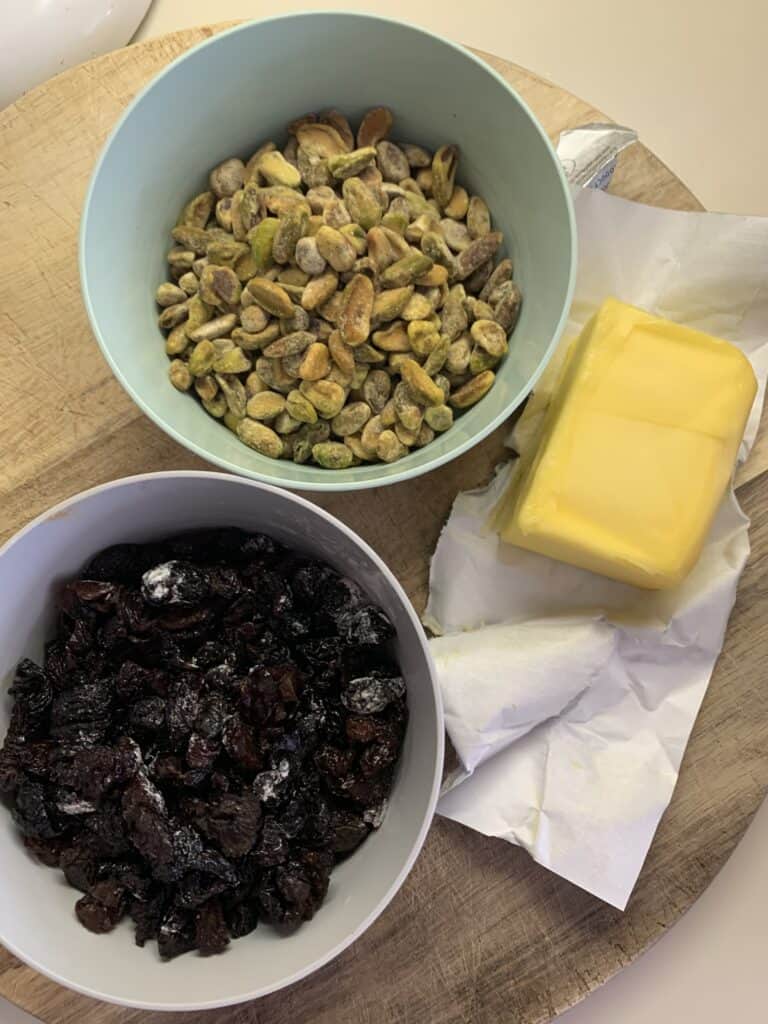
Making the first and second doughs
Below is a very brief overview of making the doughs. Making the first dough (looks like batter initially); when it’s done it, you should be able to pull a windowpane. After the first dough rise and mixing of the second dough, you will add in your mix-ins. Finally, the risen dough is shown, and final baked panettone. Immediately skewer the bottom and hang in large pot or between two chairs.
You will have about 20 seconds to skewer and invert the panettone before it may start to collapse so work quickly!
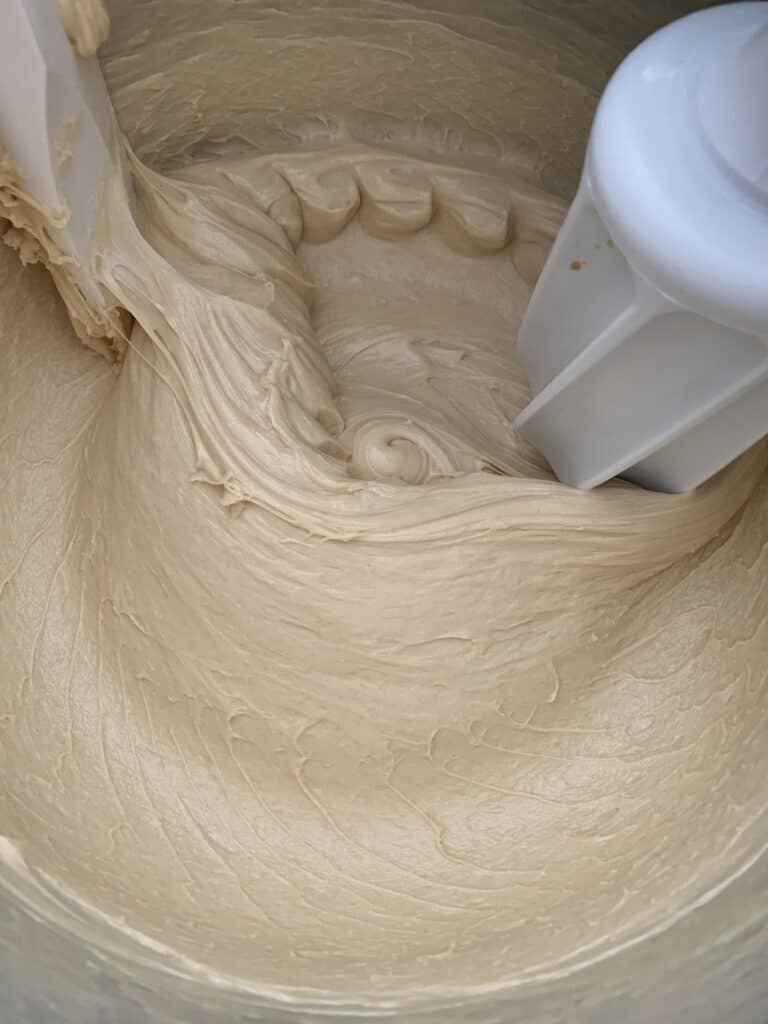
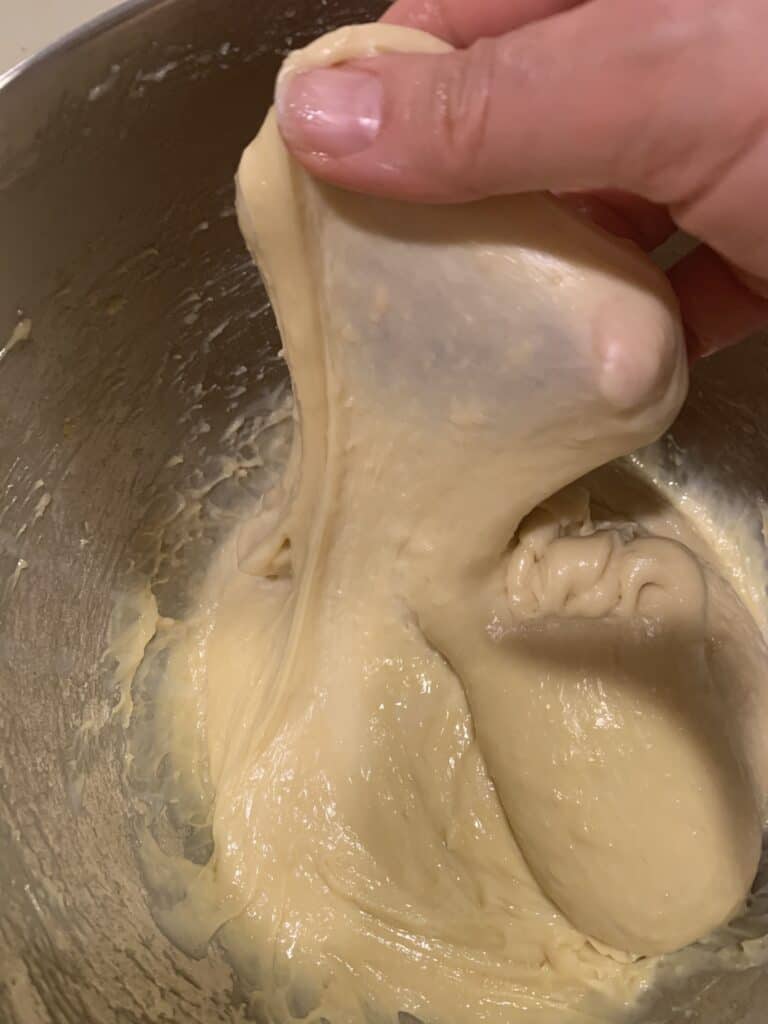

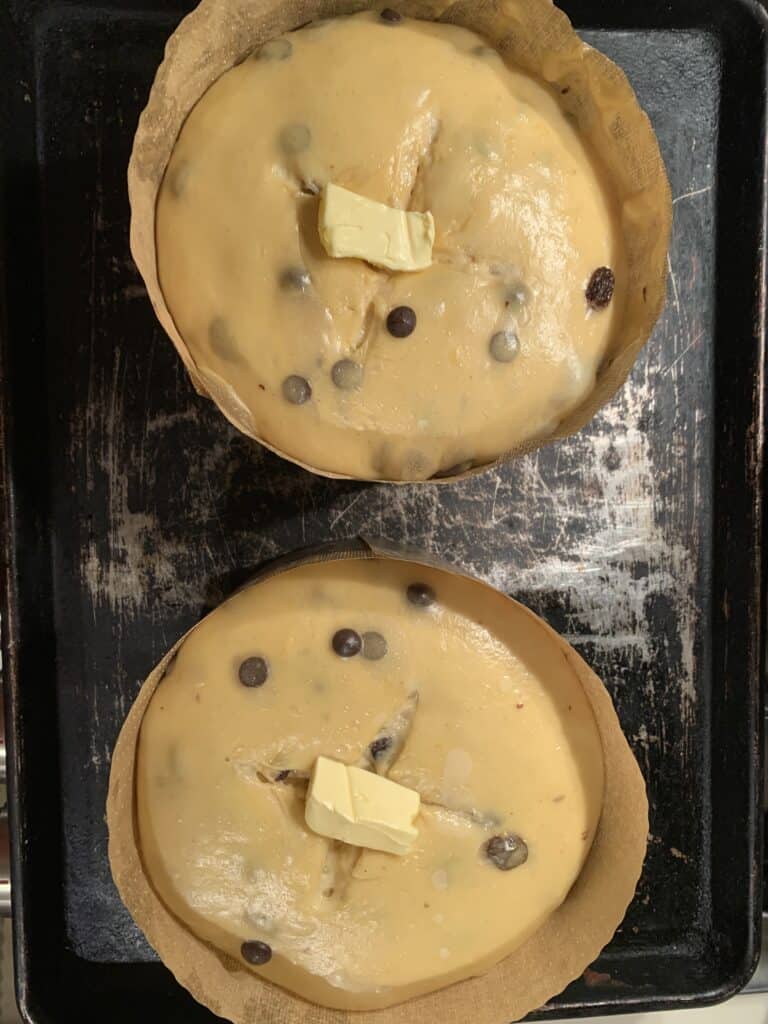
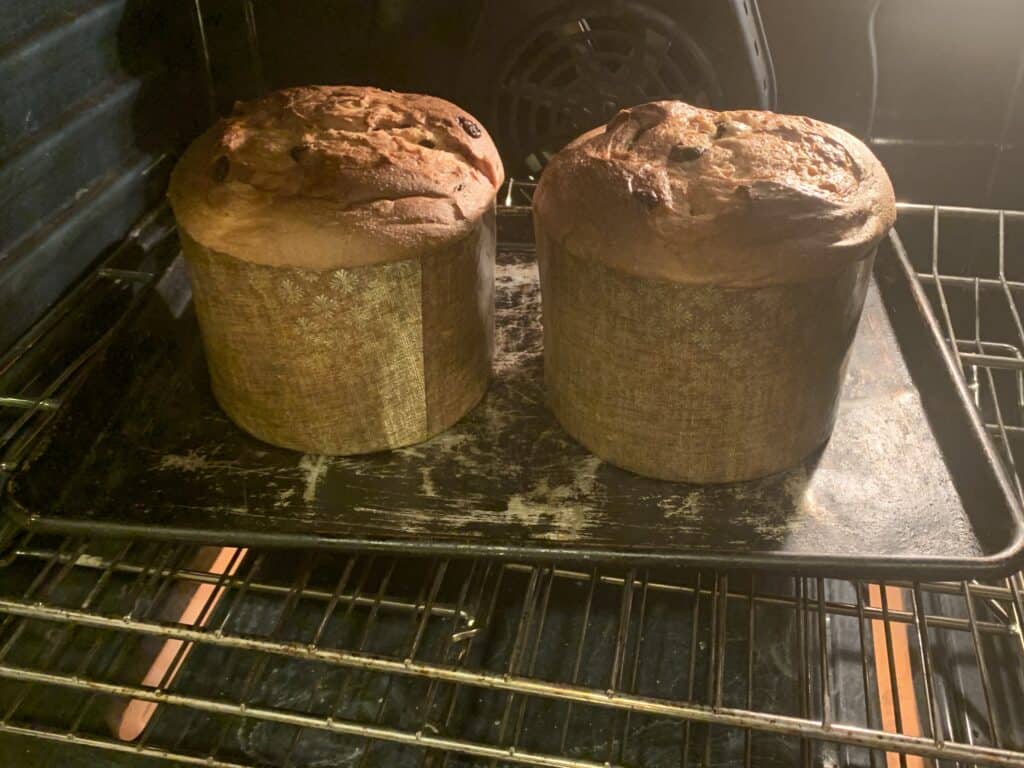
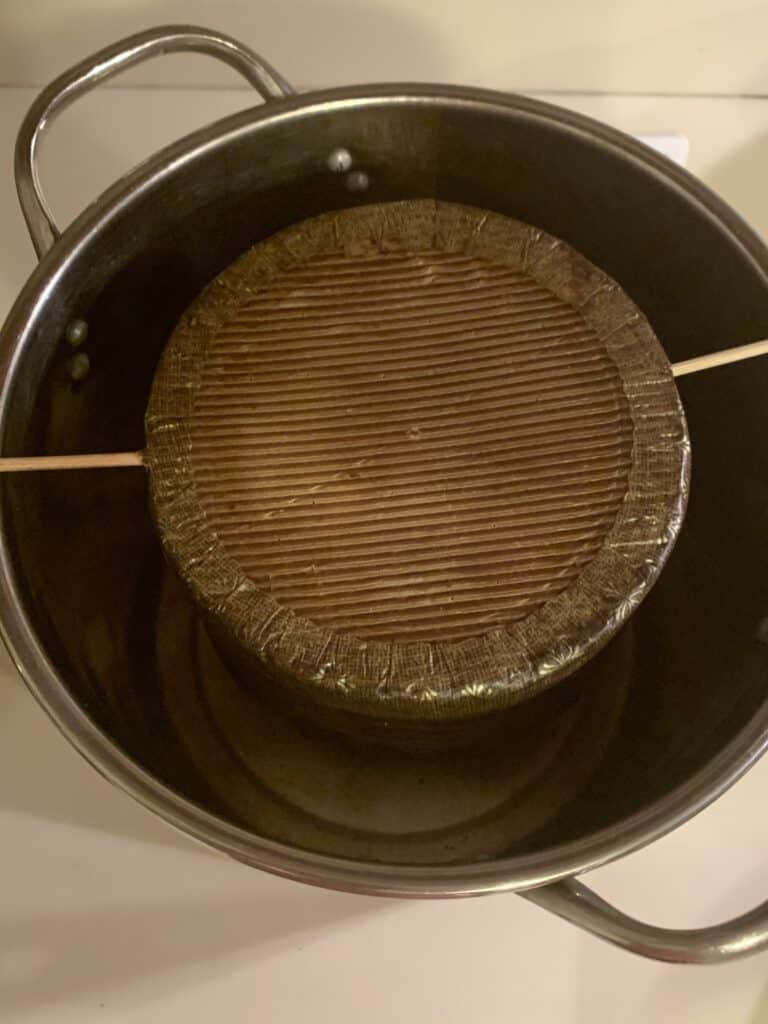
The results are very worthwhile and these make impressive gifts for those who enjoy homemade baked goods!
Panettone: The crumb
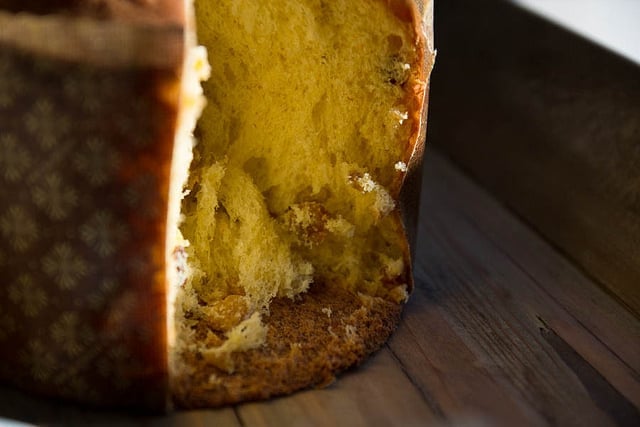
Above and below are crumb shots of the panettone: the goal is getting a beautifully soft and shreddable crumb.
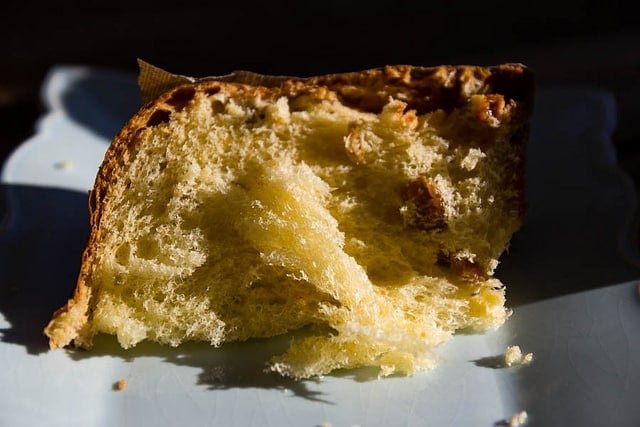
I couldn’t resist including several photos of the inside of the panettones I’ve made over the years; the inside is super soft and shreddable.
The use of natural leavening/starter provides this soft interior and also helps keeps the panettone fresh for days to weeks, depending on the amount of dextrans produced, according to a book by Bread-Editions, called Sourdough Panettone and Viennoiserie. (this book is highly technical and geared toward professional bakers or very serious home bakers.)
The balance of bacteria and yeasts, including the specific strains is a major subject in it’s own right and the reason why panettone masters will refresh their mother dough/pasta madre/starter several times over several days at specific temperatures.
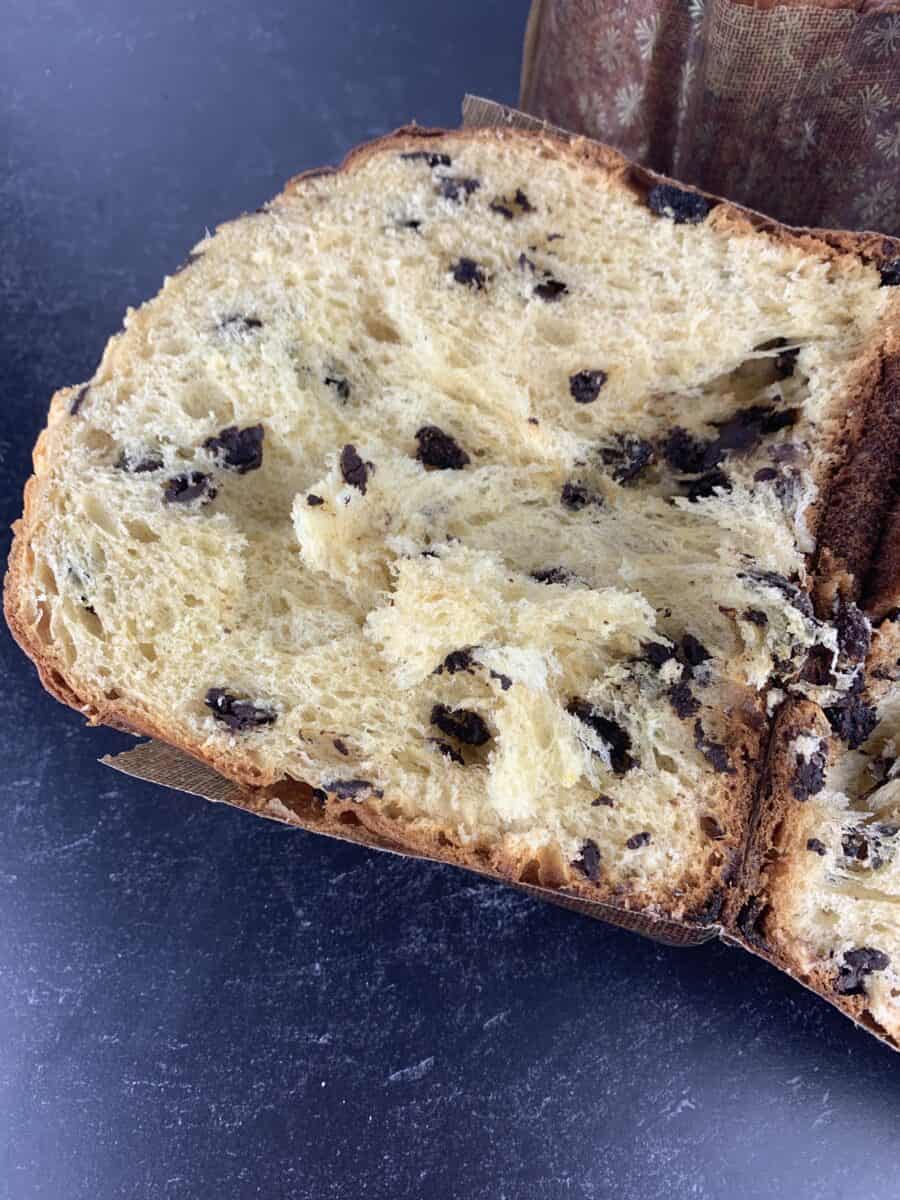
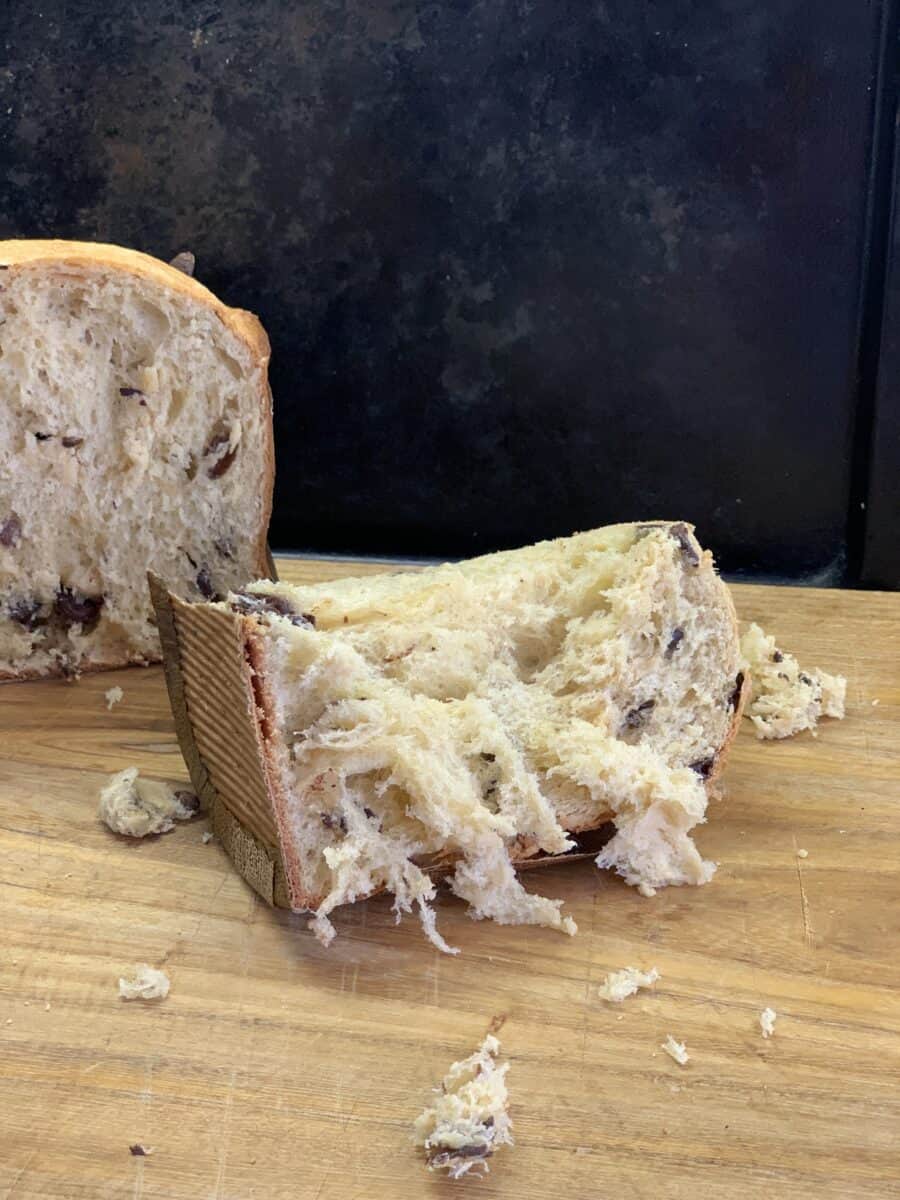
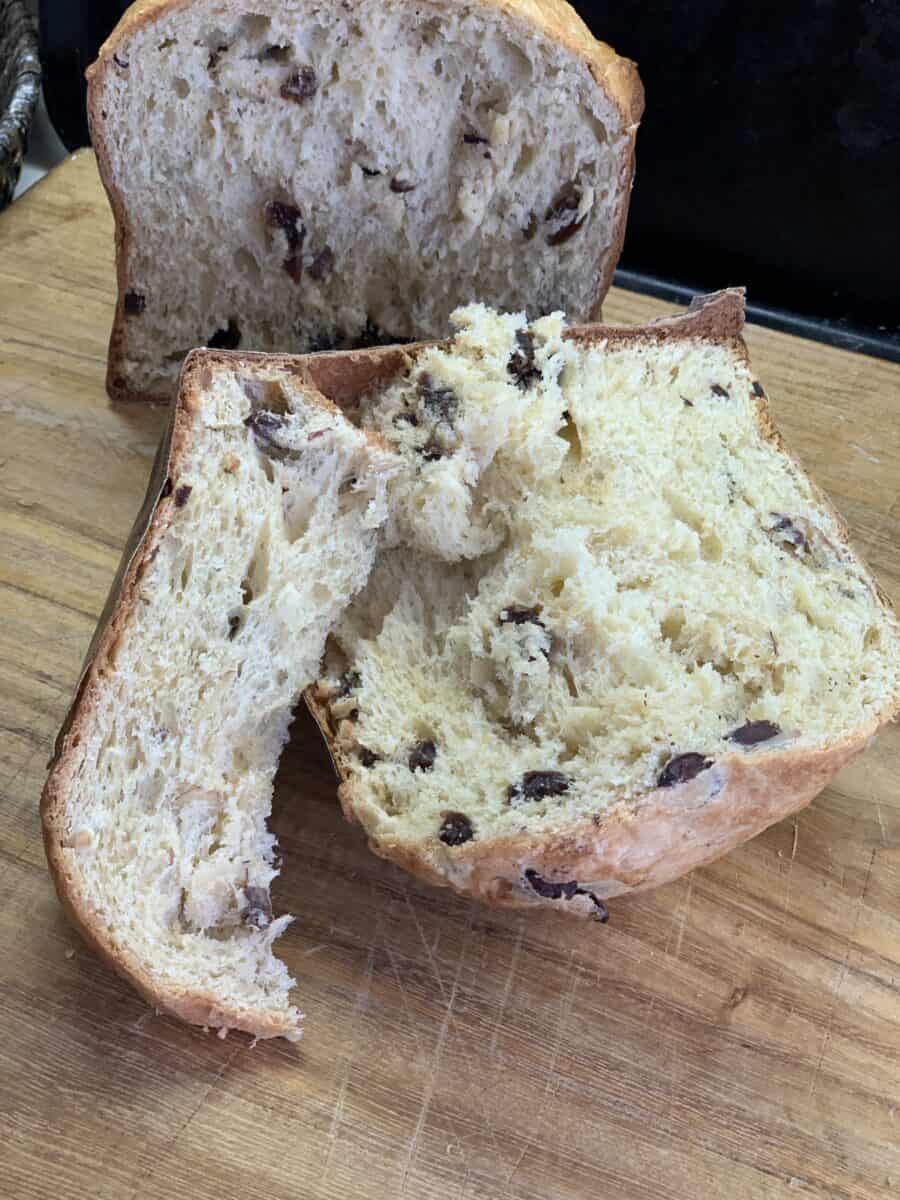
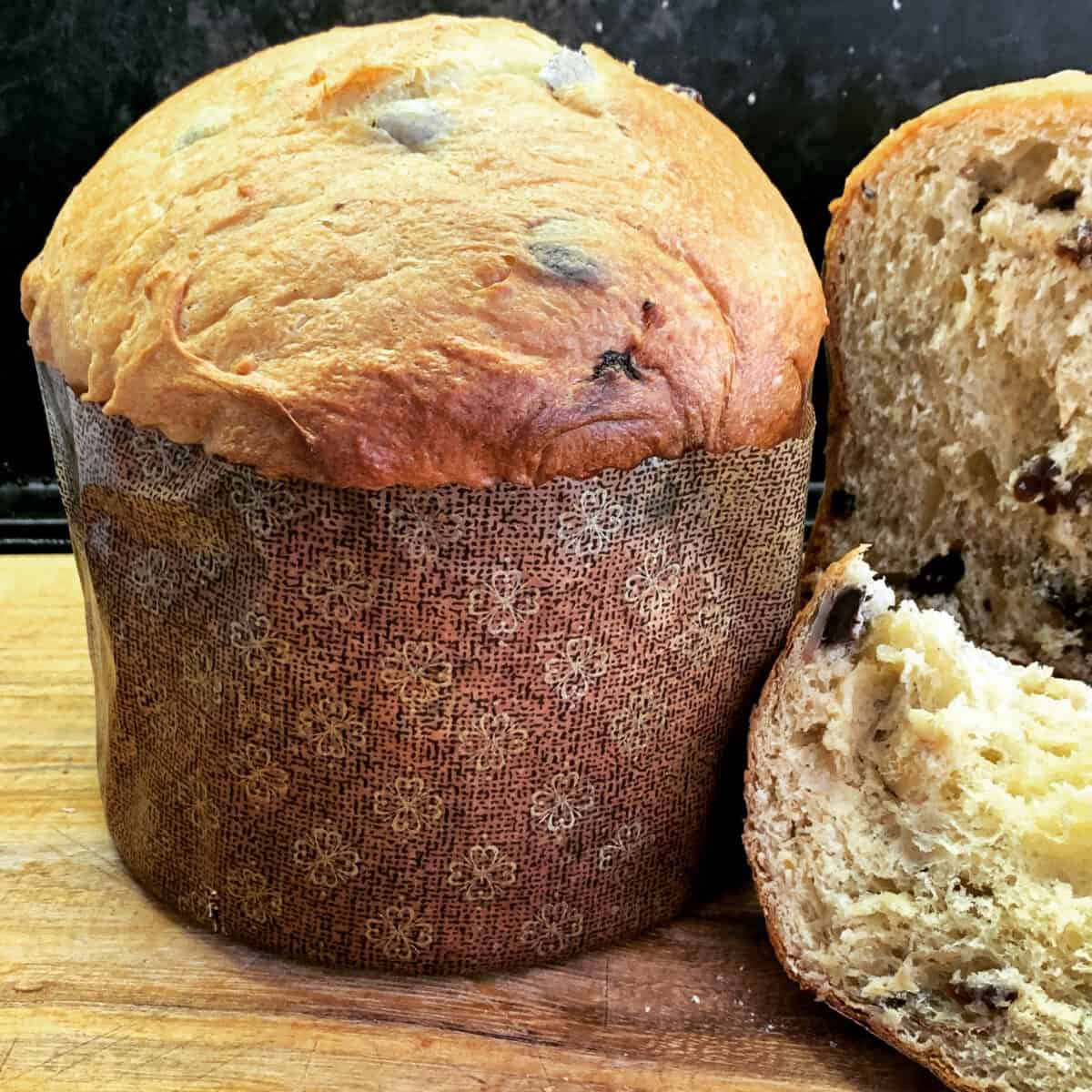

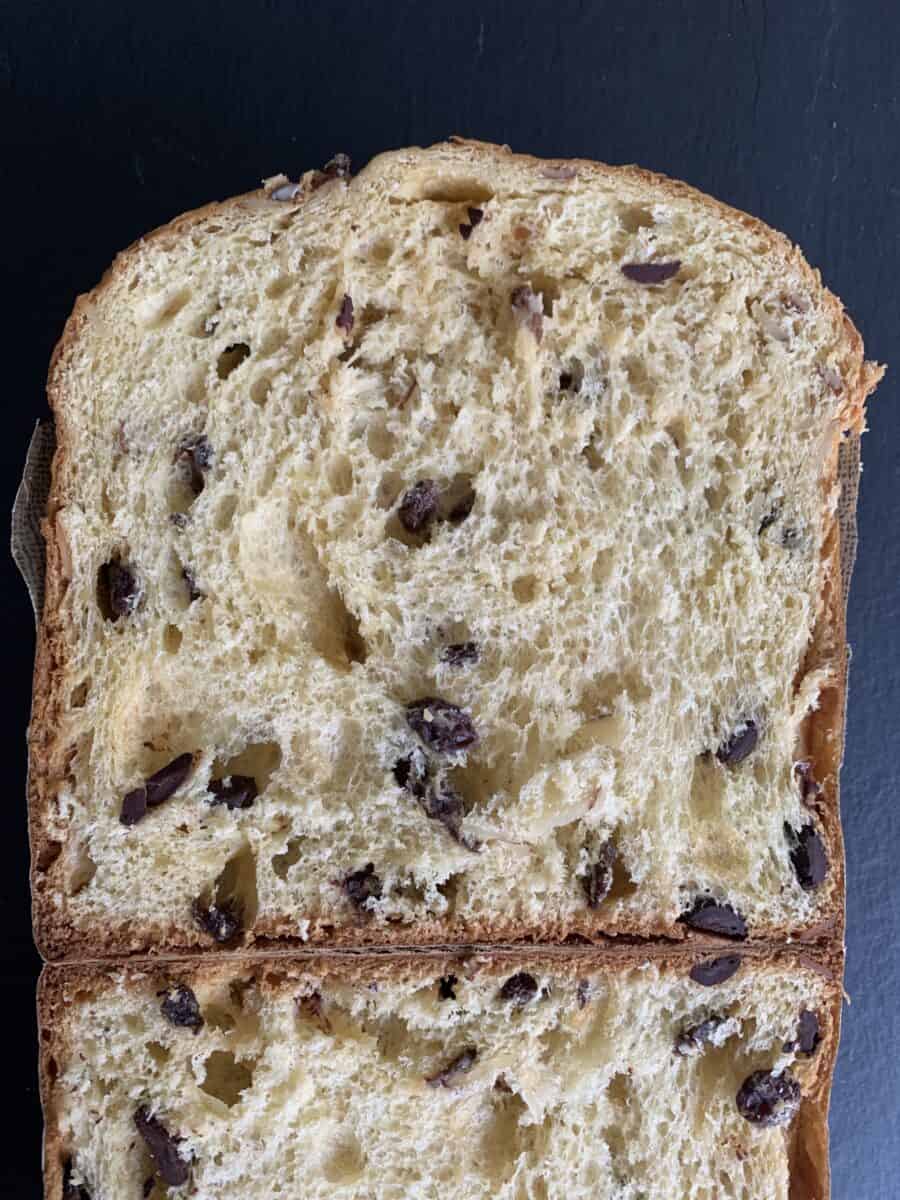
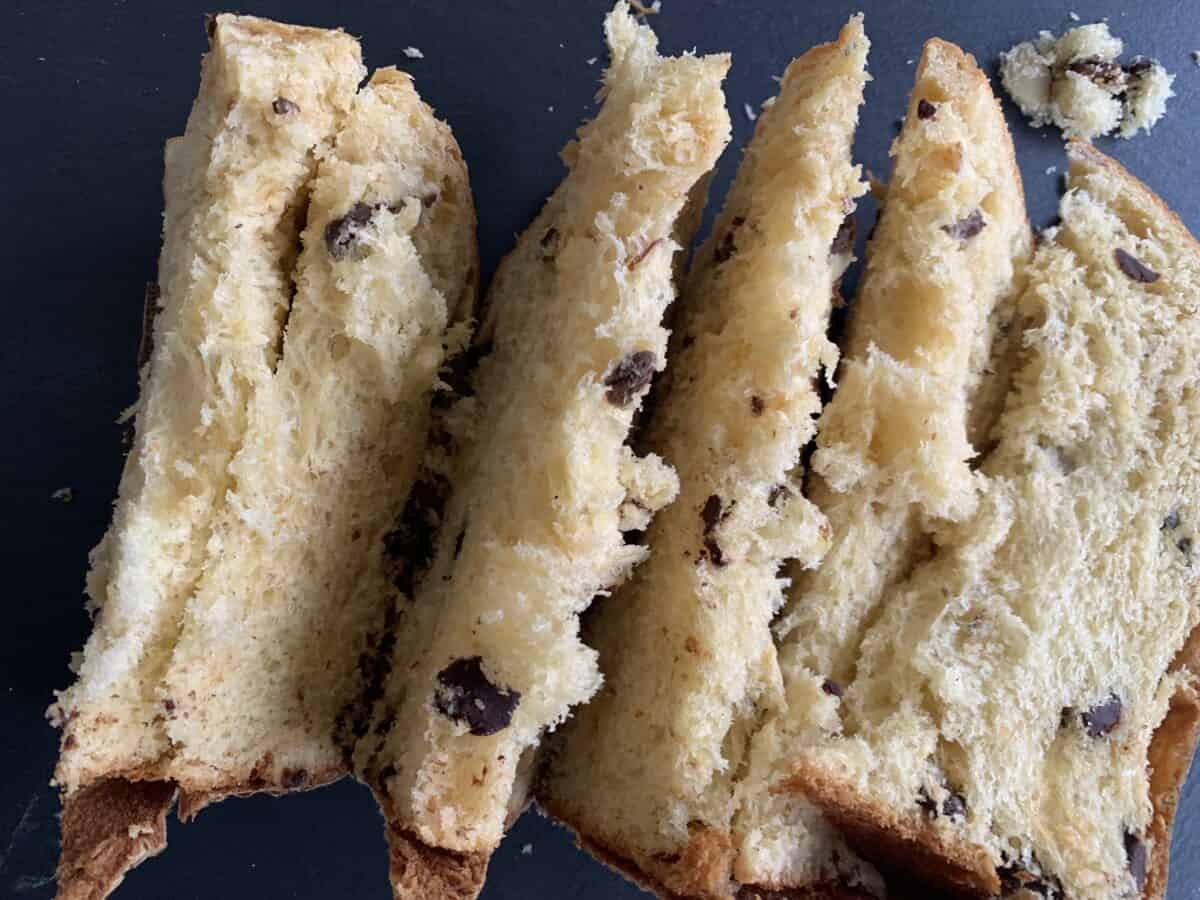
What is 320/350 Flour (W-strength)?
The strength of the flour is important when making panettone because you need a very strong gluten network to support all that butter and all those egg yolks you will be adding.
The figure below is shown in Italian, but it is easy to view the flour strength ratings (ie, W-strength) from low (blue) to high (red).
Low W-strength absorb less water, have lower protein content, and leavens more quickly. Conversely, high-strength flours absorbs more water, take longer to ferment, and have a higher protein content.
Note the corresponding protein content ranges for each W-strength rating:
- 9-10.5% (W90/W130)
- 10-11% (W130/W200)
- 10.5-11.5% (W170/W200)
- 12-12.5% (W220/W240)
- 13% (W300/W310)
- 13.5-15% (W340/W400).
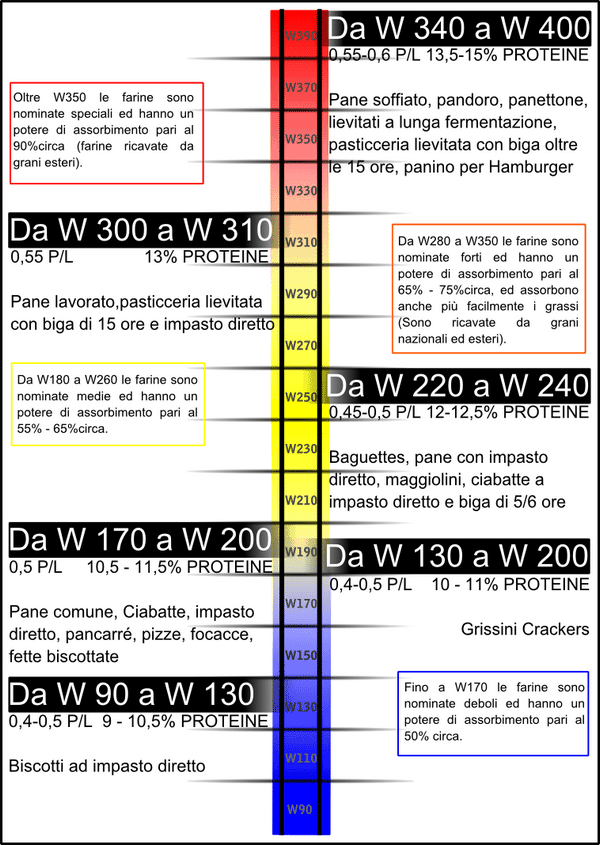
Tips for Making Panettone
- Your starter or levain must be in very good shape and not acidic at all. You must refresh three times during the day of mixing the first dough. Suggested time table is 9AM; 12noon; and 4PM and then make dough at 8PM.
- Some experts recommend it is best to complete three cycles of refreshments (that is, over a total of 3 days, refresh your starter 3 times daily)
- Use the same flour to feed your starter that you do to make your panettone.
- Follow a well tested recipe (Giorilli, Massari, etc).
- Ensure your dough is well kneaded and well developed.
- The dough needs to be strong in order to absorb and carry the fats in the high amounts of butter and egg yolk.
- It may seem like it will take a very long time for the dough to finally come together. At times, I have even let the dough rest a few minutes before continuing to mix.
- Eventually, what seems like a batter will turn into a very soft and wet dough.
- Use the highest quality ingredients, including vanilla bean or real vanilla extract, not imitation.
- Measure out all ingredients before starting so you can concentrate on the dough development.
- Monitor the temperature of the dough!
- The ideal dough temperature is 77 degrees F to a maximum of 82.5 degrees F.
- If the dough temperature rises above 86 degrees F, you risk degrading the gluten.
- If in doubt, place dough in the refrigerator to cool before proceeding. Monitor during the long mix.
- Conversely, dough temperature below 71 to 72 degrees F will result in gluten not developing properly and give you a very slow rise.
- Thank you to LievetoNaturale for these tips!
How Much Dough for Different Sized Panettone Cases/Molds?
There is a fantastic dough calculator available via an Italian website called LievetoNaturale.
This calculator will recommend how much dough to make according to the diameter and height of your panettone mold.
You will be asked to input the diameter of the bottom in centimeters and the height of the mold in centimeters. After inputting these numbers, hit enter. You will see the amount of dough (in grams or kilograms) that is recommended for each size mold.
Please note that the recipe shown below is for 1 kg of dough; you can split it up if you have the appropriately sized smaller liners. Again, use the calculator to figure out what amount of dough you need.
Where to Buy Panettone Cases
- Fante’s
- Amazon
- Walmart
- BakeDeco
- Sur La Table
Storing Panettone
Once the panettone is completely cooked, it should be stored in a polypropylene or cellophane food bag. Otherwise, it will start to harden.
The panettone can be stored for a long period (up to 60 days for some, depending on recipe and the dextrans produced), thanks to natural leavening, but you should spray the inside of the food bag with pure alcohol to reduce the risk of the formation of mold.
Make sure the panettone has been completely cooled and the bag, if sprayed, is completely dry.
Also note that the flavor of the panettone is said to be best approximately 5 days after baking.
Sources: Giallo Zafferano and Lieveto Naturale
How to adjust the amount of dough in the recipe below (if you need more or less)
The following links (in Italian or in English) describe the adjusted amounts to make more or less dough than shown in recipe below (recipe below shows 1 kg of dough).
The links below will give you ingredient amounts for the following sizes of panettone:
- 1 loaf weighing 750 grams.
- 2, 3, or 4 loaves weighing 750 grams each.
- 2, 3 loaves weighing 1000 grams each.
PANETTONE-GIORILLI-DOSI-PIROTTINI (in ITALIAN)
PANETTONE GIORILLI INGREDIENTS BY DOUGH WEIGHT (in ENGLISH)
Other Highly Regarded Panettone Recipes
Note: These are in Italian; use Google translate or other translation services.
- Morandin‘s recipe
- Massari‘s panettone recipe
- Montanari‘s panettone recipe
- Andrea Tortora’s panettone recipe (this seems less labor intensive as far as starter refreshments go and one recipe I would like to try next).
Keep in mind you can make your own homemade lemon paste, which some recipes call for.
Additional Reading on Pasta Madre and Panettone Making
- Some reading that I found helpful on starting and maintaining pasta madre:
- Bake Street
- Staff of Life
- Wild Yeast blog (panettone tips)
- Various posts on the Fresh Loaf including this one.
- Management of natural solid starter (pasta madre) (In italian, you’ll need Google translate)
📖 Recipe
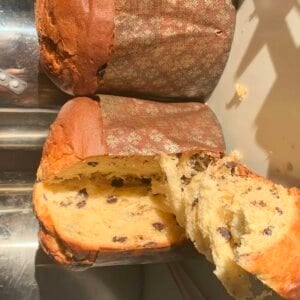
Panettone (Giorilli’s recipe)
Equipment
- Standing mixer
- Panettone cases (some call them liners)
- Skewers to insert into the panettone after baking to invert (prevents collapsing)
- Digital thermometer (highly suggested)
Ingredients
First dough:
- Levain , 50 g (100% hydration) (or 75 g of 45% hydration)
- 75 g sugar (superfine/caster) (see note)
- 120 g water
- 55 g egg yolks (about 3 or 4)
- 75 g butter , softened not melted and cut into several pieces
- 265 g high gluten flour (13.5% to 15% protein) (if using stiffer levain [45% hydration, use 240 g flour)
Second dough:
- 60 g high gluten flour (13.5% to 15% protein)
- All of the aromatic mix (recipe follows)
- 1/2 teaspoon salt (~3 grams)
- 70 g sugar (superfine/caster)
- 95 g egg yolks (about 5 or 6)
- 95 g butter , softened (not melted)and cut into several pieces
- 2 g barley malt (about 1/4 teaspoon)
- 120 g white raisins , soaked
- 60 g candied orange , diced small
- 30 g candied citron , diced small
Aromatic mix:
- 30 g honey
- 1 vanilla bean
- half lemon grated
- half orange grated
Egg wash (optional)
- One egg beaten with a splash of milk or cold water
Instructions
***Day 1***. Overview and Preparation
- Overview of day 1: prepare aromatic mixture (will sit for 24 hours until day 2), soak raisins (soaks for 1.5 hours), refresh levain/starter 3 times throughout morning and afternoon (example, 8AM, noon, and 3PM), and then make first dough in evening (45 mins to 1 hour active time)
Mix Aromatic Blend and Soak Raisins
- To begin, mix ingredients for aromatic blend in a small bowl, cover and let sit for 24 hours
- Rehydrate raisons by soaking them in bowl of hot water for 30 minutes, rinse well and then soak again in warm water for 1 hours. Drain, squeeze out all water, and then place on cloth lined baking sheet and cover with clean dry cloth, and let sit overnight. Make sure to re-weigh raisins once hydrated because you will need less as they will weight more.
Refreshing your Starter/Levain (Liquid)
- Ensure that your levain (liquid or stiff) has been refreshed enough times so that it is very active (suggestion is at least 3 refreshers the day that you are making first dough) (eg, refresh at 8AM, noon, 3PM, and then use some to make first dough at 7PM)
Mixing the First Dough
- When ready to mix the first dough, add the levain to the bowl of a standing mixer, along with flour and water.
- Mix for 10 to 15 minutes, then add sugar and then softened butter in several pieces.
- Only after butter is completely blended, add the egg yolks in several stages.
- Ensure that the dough temperature stays under 26 degrees C (78F). If it goes higher, place dough in freezer for 10 minutes (remember this for second dough too)
- Mix for 25 minutes until you get a silky smooth elastic dough. Test dough for windowpaning.
Bulk Rise of First Dough (12 hours/overnight)
- Place dough in large container (three times the size of the dough), cover, and let rise at 28/30 C (82 to 86F) for 12 hours. You may leave the covered dough inside the oven (turned off!) with the oven light turned on for warmth if you have a cool kitchen.
***Day 2***. Overview and Mixing of Second Dough
- Overview: Make dough two (45 mins), form loaves/rest dough (1 hour), let loaves rise (6 to 9 hours), and bake (35 mins to 1 hour, depending on liner size, see note)
- To begin, consider placing dough/bowl/hook in refrigerator while measuring ingredients for dough two
- When ready to proceed, add flour and barley malt to the day 1 dough and mix at slow speed than medium for 15 minutes
- Slowly incorporate sugar
- Afterwards, add half the egg yolks, salt, and aromatic blend.
- Knead until smooth and homogenous
- Add 70 grams of the softened butter, mix well, and then the rest of the yolks.
- Knead until smooth and then add the remaining butter, the raisins, and the candied fruit.
Bulk Rise of Second Dough
- Remove from machine and let stand in covered bowl for 30 minutes
- Remove dough from bowl and let sit uncovered on counter for 15 minutes
Final Rise of Second Dough
- Divide dough and form into balls sized according to size of the containers/pans/liners you are using (see notes)
- Allow loaves to rise in liners placed on a on baking sheet, covered by plastic wrap at a temp of 28 to 30 C (82 F to 86F) for 8.5 to 9 hours. You may leave the covered dough inside the oven (turned off!) with the oven light turned on for warmth if you have a cool kitchen.
- The dough should rise within 1 inch of top of mold. If it rises more than that, you risk getting a mushroom shaped panettone, which is not considered ideal.
Preparing to Bake
- In the meantime, before baking, pre-heat the oven to 165 C (330 F) and allow panettone to form skin by uncovering for 15 to 20 minutes prior to baking
- Cut a cross on top of panettone prior to baking and add a chunk of butter to the center (see photo collage) If you want shiny loaves, consider brushing top with egg wash
Bake loaves
- Center should read 94 C (201 F) when done (takes about 50 to 55 minutes for 1 kg dough; see note for baking according to size)
Invert and cooling of loaves
- To cool, immediately invert loaves by inserting wooden skewers across bottom and hang upside down on top of deep pot (see photo collage) (NOTE: you should use very pointy skewers or it may be difficult to pierce the panettone liners (I twist them for easy insertion; some folks pre-skewer their liners before baking. The loaves stick to the side of liners so they should not fall out. When serving, it is okay to cut right through paper and peel it off).
- After completely baked, place the loaves in plastic/cellophane bags. Before wrapping in plastic, you must wait 10 to 12 hours for loaves to completely cool. (to reduce risk of mold, consider spraying inside of bags with pure food grade alcohol and dry out completely before using)
- Panettone is best eaten at least 5 days after baking as the flavors continue to develop after baked.
Notes
*Dough should occupy about 1/3 of the panettone liners
**Liner sizes:- 1228 g dough: 12.5 cm high x 18 cm wide (~6 x 8 inches)
- 964 g dough: 11 cm high x 17 cm wide (~5 x 8 inches)
- 595 g dough: 10 cm high x 14 cm wide (~4.5 x 6.5 inches)
- 394 g dough: 9 cm high x 12 cm wide (~4 x 5.5 inches)
- 100 g dough: 5 cm high x 7 cm wide (~2.5 x 3 inches)
500 g dough: 35 minutes at 170/180 C (340 F to 360 F)
1000 g dough: 50 to 55 minutes at 170/180 C (340 F to 360 F)
1500 g dough: 70 to 75 minutes at 170/180 C (340 F to 360 F)
2000 g dough: about 90 minutes at 160/170 C (320 F to 340 F) After baking, bread must be immediately skewered and turned upside down to prevent deflating! Leave this way for 10 to 12 hours Variations: Can soak raisins in rum; other dried fruit can be used, ie, cranberries, cherries, etc Source for ordering panettone liners: Fantes.com

Third time making this recipe and I finally found the perfect panettone recipe I was looking for. Thank you.
Your site has some fantasticly helpful information! I do think that you may want to correct the weights for the dough portions for various sizes of molds as it seems unlikely that the units should be in KILOGRAMS, instead of grams. I have printed out the recipe and am looking forward to making it this week. Bon Apatite!
Thank you! Updated and grateful for your help with that!
Hi, I have been baking panettone for years using your recipe and this year, as usual, the dough didn’t rise much in the oven. Instead of a beautiful dome, what I usually ended up with is a mole hill. Is there anything that I’m not doing correctly? My stiff starter is active though. Thanks.
Hi KL, Panettone is a tough bread to perfect. I would suggest posting your process on a panettone group such as this one (using translate) and get some group feedback. If I had to guess, the most common things are temperature and how the dough is developed. Also type of flour and condition of the levain (pH) – so many things.
Hi there, Marie! Can you please help me get a 45% hydration starter from my 100% hydration starter? Thanks in advance!
I’m so sorry Anna – this is probably too late but here are my thoughts: to convent the liquid starter to pasta madre, you will use the following ratios of starter to flour to water over the next several freshments. Remember to store the pasta madre at ideal temperatures between refreshments (79F to 82F) and to store it at the lower temperature (64.4F) for the overnight rest.
100 grams starter, 100 grams flour, 100 grams water
100 grams starter, 100 grams flour, 85 grams water
100 grams starter, 100 grams flour, 70 grams water
100 grams starter, 100 grams flour, 55 grams water
100 grams starter, 100 grams flour, 45 to 50 grams water
Thanks Marie! It was indeed a bit late 😁 but it didnt stop me from making it. I made it with liquid starter. The crumb was not as perfect as om the pics but it tasted amazing. Thanks for the recipe and the tips. I will be trying again this Easter 😊
Hey there – I made the first dough 12 hours ago and it hasn’t risen at all. My starter was definitely in the right state when I used it but there’s been zero rise in the dough. I could only leave it to prove in about 24c conditions. Is that simply too cold to do the first prove or do I just need to let it prove for longer?
24ºC is not ideal but in my opinion it should be enough to deliver a rise specially after 12h. If you experience issues with rising, from my experience it is always to have a little more heat than deficit of it – as the recipe calls, if you have an oven that you can lit the lamp on, do so, or a program that allows you to go as low as 30ºC (plate warming, etc.); this is usually the program I use on winter, to proof doughs, i turn it on and off every 2h or so. This is important because moisture not only helps fermentation, it also disallows for the crust to form.
Also make sure that your dough is not exposed to open air, that is, keep it in a container, or closed in the oven – I always make it a little moist with a pulverizer as well.
A bit more technical, butter can easily solidify under about 28ºC, and this dough is very heavy on butter, I suppose being in low temperature won’t help. In fact, most professional recipes usually call on adding watery ingredients (such as water itself) at a specific temperature that compensates the room’s, in this way, fermentation starts right away. For this recipe, I add butter in a molten state, for a faster integration, and to allow for the dough to be in the ready-state. Molten, not hot (what I do is melt until about 60-80% of it is molten, even if some sections still appear solid).
I’m not sure if this will help but I have no other hypotheses on to why it is not rising, if you are positive it was in a good state.
You can also add 0.2-0.5g of fresh yeast to help with blooming.
Hey there – I am going to give this a go for this Christmas.
Just a couple of questions:
1. Is the barley malt a powder of “barley malt extract” like a liquid? Just trying to work out what to get on Amazon.
2. If I want to add chocolate chunks instead of raisins, is it just a 1:1 exchange? i.e. if there are 120g raisins, can I substitute with 120g of chocolate?
Yes, I use the liquid barley malt because I also use it to make my NY Bagels. And yes, you can substitute the inclusions 1:1 with anything you’d like.
Hi Marie, I am itching to make this and thank you for having a recipe that uses a liquid starter because there is no way I would even attempt a lievito madre! I could make a stiff starter but I will opt for the liquid starter. Mine is very active.
Question: DAY2 overview, you say to proof the 2nd rise 6-9 hours but further down you mention 8.5-9 hours. I am assuming you are referring to the same rise? Also, where you mention to preheat the oven, maybe remind everyone that if they are proofing their panettone in the oven to remove them before turning the oven on. It’s easy to forget!
Also, if I’m making a 750g bread, thank you for the conversion link, what would be the baking time? I’m putting chocolate chips instead of the candied citrus and raisins. Any recommendations? Thank you, I’m hoping to start this tomorrow night.
Sharon
Hi Sharon – yes, those are the same ranges – I believe it took me longer so I mentioned 8.5 to 9 hours but if your starter is very active, maybe sooner. The liquid starter should be young and not sour at all. I must admit most people don’t use liquid starter, so if you’d like to try a recipe with the stiff starter, look under the section “Other HIghly Regarded Pannetone Recipes” and think about giving Andrea Tortora’s a shot or even compare them if you have time. The bake times for various sizes are in the Notes section of the recipe card but I see nothing for 750 grams of dough. 500 grams would be 35 minutes and 1000 grams would be 50 to 55 minutes so try 40 to 45 minutes. Happy Baking!
Hi Marie. So I started the journey. When I was making the first dough with the starter, flour water, it came together and I mixed it about 25 minutes. Then when I added the sugar – this is where I think I made a mistake. It didn’t look like the sugar was going to incorporate and I started adding the butter which looked like a mess and then the eggs – and it was quite grainy. However, after 45 minutes it came together. I’m hoping the dough will rise. It’s in my oven with the light on. I’ve made the aromatic blend.
On a side note, I have made a stiff starter which depending on how this one fares, I might try a second one.
My mistake was not being patient enough when adding the sugar. Any thoughts?
I’ve never had that problem – how did the first rise go?
Hi, would love to try this recipe. Can you explain barley malt to me pls…is it a liquid form ? Many thanks in advance. the panettone you have baked looks absolutely amazing and drool-worthy!!
it’s used in such a small quantity, you could probably safely skip it and most panettone recipes that I’ve seen don’t include it. You can typically find barley malt syrup in health food stores or Amazon (I’ve purchased in both those places) and I hear home brewing supply places also carry it. If you try my NY Bagel recipe, I’d definitely buy some 🙂
Hii Marie, loved your blog! I have been baking panettone based on your recipe for the past 3 christmases. Every year I have the same issue which I am unable to resolve. Why does the panettone rise as much as yours? I dun think my dough was overly mix or overproofed becos I always have a soft and fluffy product. My yeast is active enough to see thru all the steps. It is only when in the oven, it just doesn’t rise as much. Do you know what’s the reason? Thanks a million.
Are you using the right sized container? Perhaps a smaller panettone case would help?
I am more excited that you are using Ankarsrum because I could not be sure I could get the right results as a beginner (given I did the rest of the recipe right :)) !!! I will give it a shot thank you!
Thanks Marie. I baked it twice. Followed your instructions to the T. Very helpful. I find shaping the final dough really difficult. It is very soft and sticky. Any tips?
you can try buttering your countertop and hands lightly
Hi Marie
Thank you for a really comprehensive recipe. I’m preparing to bake panettone using your recipe.
Can I swap the fruit for chocolate and nuts? I’d like a choc chic and hazelnut panettone and I my wife prefers plain. Any advise on omitting the fruit? Can I use the same weight as the fruit for chocolate and hazelnut?
Can I keep the same recipe and not include the the fruit for plain panettone?
Thanks
Rob
Yes, I do this all the time – you can absolutely substitute the inclusions for anything you’d like. Make sure your starter is in really great shape and has been adequately refreshed and not sour. In my experience this is one of the main determinate of success
Hi Marie
Thank you for the reply.
I’ve maintained a 100% hydration starter for years. The stiff starter seems to be very challenging to get the hang of. I might be over thinking it but It seems overly complicated to get it ready for a panettone bake.
Do you have any suggestions about higher hydration vs the traditional pasta madre? Any good resources for getting your pasta madre ready for panettone?
Thanks again!
Rob